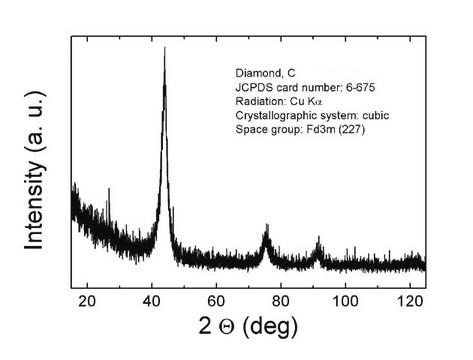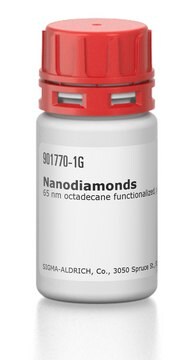483591
Diamond
synthetic monocrystalline powder, ≤1 μm
Sign Into View Organizational & Contract Pricing
All Photos(1)
About This Item
Empirical Formula (Hill Notation):
C
CAS Number:
Molecular Weight:
12.01
EC Number:
MDL number:
UNSPSC Code:
12352103
NACRES:
NA.23
Recommended Products
form
synthetic monocrystalline powder
Quality Level
particle size
≤1 μm
density
3.5 g/mL at 25 °C (lit.)
application(s)
battery manufacturing
Looking for similar products? Visit Product Comparison Guide
Related Categories
Application
Monocrystalline diamond particles internalized in human endothelial cells have potential applications in drug delivery.
Storage Class
11 - Combustible Solids
wgk_germany
nwg
flash_point_f
Not applicable
flash_point_c
Not applicable
ppe
Eyeshields, Gloves, type N95 (US)
Choose from one of the most recent versions:
Already Own This Product?
Find documentation for the products that you have recently purchased in the Document Library.
Micron-sized diamond particles are internalized by endothelial cells.
Walkowiak B, et al.
Diamond and Related Materials, 18, 651-656 (2009)
Pontus Forsberg et al.
Optics express, 21(3), 2693-2700 (2013-03-14)
Control of the sidewall angle of diamond microstructures was achieved by varying the gas mixture, bias power and mask shape during inductively coupled plasma etching. Different etch mechanisms were responsible for the angle of the lower and upper part of
P Pereira Nogueira et al.
The Journal of clinical pediatric dentistry, 37(1), 53-57 (2013-01-25)
The aim of the present study was to evaluate hybrid layer thickness of primary molars sectioned with diamond, carbide and ultrasonic CVD burs. The occlusal enamel surfaces often molars were removed and superficial dentin was exposed. Three standardized cavities were
H Pinto et al.
Journal of nanoscience and nanotechnology, 12(11), 8589-8593 (2013-02-21)
We have investigated using density functional theory the effect of fluorine termination of a (001) diamond surface on the electronic energy levels of an NV- centre buried beneath the surface. We find that, like OH termination, fluorine passivates the surface
Richard W Bowman et al.
Physical review letters, 110(9), 095902-095902 (2013-03-19)
Diamond anvil cells allow the behavior of materials to be studied at pressures up to hundreds of gigapascals in a small and convenient instrument. However, physical access to the sample is impossible once it is pressurized. We show that optical
Our team of scientists has experience in all areas of research including Life Science, Material Science, Chemical Synthesis, Chromatography, Analytical and many others.
Contact Technical Service







